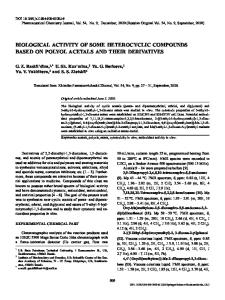A review of antimalarial activity of two or three nitrogen atoms containing heterocyclic compounds
- PDF / 3,854,889 Bytes
- 28 Pages / 595.276 x 790.866 pts Page_size
- 29 Downloads / 339 Views
Medicinal Chemistry Research https://doi.org/10.1007/s00044-020-02604-6
REVIEW ARTICLE
A review of antimalarial activity of two or three nitrogen atoms containing heterocyclic compounds Arshiya Chugh1 Ashwani Kumar1 Anu Verma1 Sunil Kumar1 Parvin Kumar2 ●
●
●
●
1234567890();,:
1234567890();,:
Received: 15 April 2020 / Accepted: 18 July 2020 © Springer Science+Business Media, LLC, part of Springer Nature 2020
Abstract Malaria, a nocuous disease, which has become a major challenge for the health resulting in deaths of millions of people around the globe. Malaria is a parasitic disease propagated by mosquitoes and infects the human beings. Several species of Plasmodium are responsible for this life-threatening disease and Plasmodium falciparum being the most virulent. In order to eradicate the malarial parasite, the researchers are making consistent efforts in synthesizing new antimalarial drug candidates by paying attention to the various drug targets. In this manuscript, the main focus is on the antimalarial activity of numerous heterocyclic compounds reported by the researchers since 2010 against the different strains of Plasmodium. Antimalarial activities of the two and three nitrogen-containing heterocycles along with their structure–activity relationship are described. Keywords Malaria Plasmodium falciparum Heterocycles Antimalarial activity Structure–activity relationship ●
●
Introduction Malaria, a vector-borne infectious disease, is one of the utmost annihilating diseases of the ever-changing world predominated chiefly in tropical regions (Ridley 2002). The World Health Organization evaluated 219 million malaria cases across the entire globe, an increment of 2 million from the preceding year and 435 thousand quietus at annual frequency as well as 1190 on daily occurrence, predominantly moppets (Tse et al. 2019). Six species of singlecelled eukaryotic Plasmodium parasites are the causative agents of malaria: P. knowlesi, P. vivax, P. ovale curtisi, P. ovale wallikeri, P. malariae, and P. falciparum. Out of all these, P. falciparum is liable for ~90% of the infections (Lee et al. 2019). Plasmodium falciparum is the most noxious and has the highest rates of complications, mortality as well as the prevalence of erythrocytic disorders globally (Buffet et al. 2011). Plasmodium is an obligate intracellular parasite that requires two hosts for the
* Arshiya Chugh [email protected] 1
Department of Pharmaceutical Sciences, Guru Jambheshwar University of Science & Technology, Hisar 125001, India
2
Department of Chemistry, Kurukshetra University, Kurukshetra, India
●
●
completion of its life process, i.e., for sexual life cycle—an arthropod vector and asexual life cycle-human host (Jensen et al. 2020). Administration of the transmissive form i.e., the sporozite into the human skin with the assistance of the female Anopheles mosquito with an anticoagulant saliva prior to the blood meal. Sporozoites intrude the lymphoid system and get dispersed to defile the liver. In the liver, they turn out
Data Loading...










